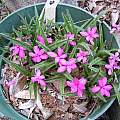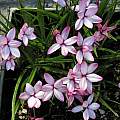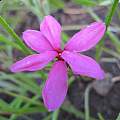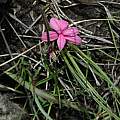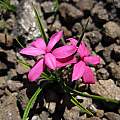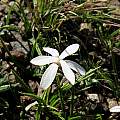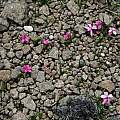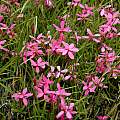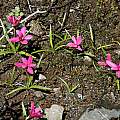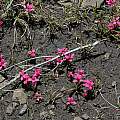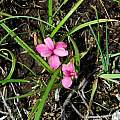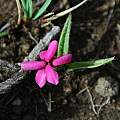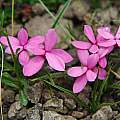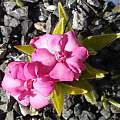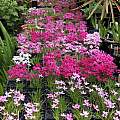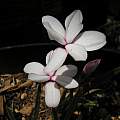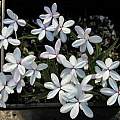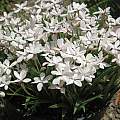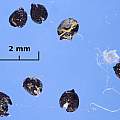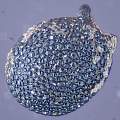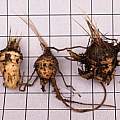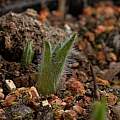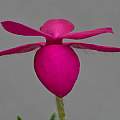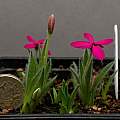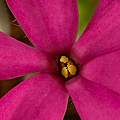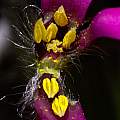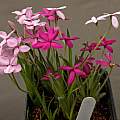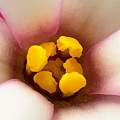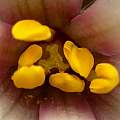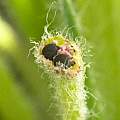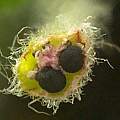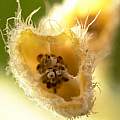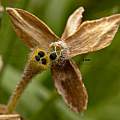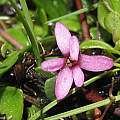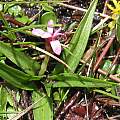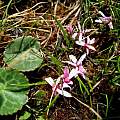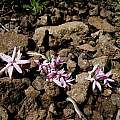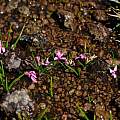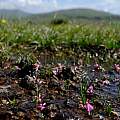Rhodohypoxis is a very short, winter-dormant genus of six species with tuberous rhizomes from the summer rainfall area of South Africa in the Hypoxidaceae family. Four of the species are confined to the Drakensberg and Lesotho plateau and since they bloom at approximately the same time there could be intergrades between species. There are many named cultivars.
Christenhusz et al. (2017) include these species in Hypoxis, which would falsify the established name ×Rhodoxis used to designate hybrids between Rhodohypoxis and Hypoxis species. Until further notice we stick to the names widely established in horticulture.
Rhodohypoxis baurii (Baker) Nel, syn. Hypoxis baurii Baker, is the most common species. It forms carpets in grassland and rocky places up to 2900 m. Leaves are dull green with sparse long hairs and a midrib grooved to the tip. Flowers are white to pink to red and faintly scented. The species is named for Rev. Leopold Baur (1825-1889) and was described in 1876. Height range: 7-15 cm. The first photo taken April 2004 by Lee Poulsen is an example of a darker pink variety that came to him with the label "Deep Pink". The second by Mary Sue Ittner is a lighter pink form. Photos three through six were taken by Cameron McMaster and Bob Rutemoeller near Maclear and at Naude's Nek.
Photos taken from Mary Sue Ittner and Bob Rutemoeller at Naude's Nek January 2010 are probably Rhodohypoxis baurii, but we also saw Rhodohypoxis rubella and it is difficult to tell them apart from the photos. They also could be intergrades between the two. The first photos illustrate the habitats they were growing in:
The photos below show close-ups of flowers and leaves:
The first photograph by Caroline Langensiepen is of a plant with double flowers. The second photograph by Pamela Harlow is of many plants.
Rhodohypoxis baurii var. baurii grows from 5 to 10 cm. and is found from 1100 to 2700 m.
Rhodohypoxis baurii var. confecta Hilliard & B.L.Burtt (considered to be ambiguous by World Flora Online, 2023) grows from 3 to 5 cm and is found on damp grassy slopes, among outcropping rocks at 1900 to 2900 m. Flowers are pink or white with some red.
Rhodohypoxis baurii var platypetala (Baker) Nel, syn. Hypoxis baurii var. platypetala (Baker) Baker, is found in short dry rocky grassland. It has mostly white flowers, occasionally pink. The first photo is a close-up of the white flowers tinged pink. Other photos from subsequent years show a greater flower display as the plants multiplied. Photos from Mary Sue Ittner.
All of the rest of the photographs of this species were taken by David Pilling. Photo 1 is of dry seed with some chaff; as shown it is common for this seed to be supplied damaged; photo 2 is a higher magnification view. It is apparent the seed is constructed from hexagons, and in the middle of each is a convex reflective surface. This is why the seeds in the low magnification photo show lots of bright twinkly colour. In the high magnification photo one can see a reflection of the round black lens aperture in each surface. The appearance of hexagons in structures like this is common in the natural world; mathematics (Euler's polyhedron formula) proves that a closed surface cannot be formed from hexagons alone. Twelve pentagons are also required (a soccer ball has 12 pentagons and 20 hexagons).
Photographs below are of plants supplied as Rhodohypoxis baurii hybrids. The first is of corms on a 10 mm grid; the far right one is an example of tiny offset corms being produced on the ends of stolons. Photo 2 shows shoots. Photo 3 illustrates the gap between two sets of three petals. Some authorities say this only occurs in Rhodohypoxis milloides (which is not hairy) and not in Rhodohypoxis baurii; flowering occurs soon after the shoots appear. The coin in photo 4 is about an inch in diameter. In photo 5 the flower is being held open.
Flowers last for a long time; the photos below show what is left at the end of the stem when the dried flowers are pulled off; of note are the three locules. The first two photos show seed; photo 3 is a flower with no seed. In photo four the flower has been bent over revealing the seed.
Rhodohypoxis deflexa Hilliard & B.L.Burtt (considered to be ambiguous by World Flora Online, 2023) is another small species growing to 5 cm found in the Drakensberg where it grows in marshy turf from 2700 to 3250 m. It has spreading leaves held nearly horizontally above the ground and small light to dark pink flowers. Photos below were taken by Cameron McMaster at Naude's Nek.
Rhodohypoxis incompta Hilliard & B.L.Burtt (considered to be ambiguous by World Flora Online, 2023) is a rare short species (1 to 5 cm) from the Drakensberg with large flowers. It is found on the edges of tussocks bordering silt patches, rock sheets at 2300 to 2900 m. It is similar to Rhodohypoxis rubella and blooms November to January.
Rhodohypoxis milloides (Baker) Hilliard & B.L.Burtt, syn. Hypoxis milloides Baker, is found in marshes from the Eastern Cape to KwaZulu-Natal from 1500 to 2450 meters. It has bright green hairless leaves with a midrib not grooved to the tip and deep pink to deep red flowers. It grows to 15 cm tall.
Rhodohypoxis rubella (Baker) Nel, syn. Hypoxis rubella Baker, is a dainty grasslike species growing up to 3 cm tall. It is found in shallow pools and seasonally flooded silt patches, mostly on the summit in the Drakensberg Mountains (2400 to 3300 m). Leaves are wiry, developing after flowering and the bright pink flowers are small. The first two photos were taken by Cameron McMaster at Naude's Nek and Tiffendell. The next two photos from iNaturalist were taken by Nick Helme in December in the Drakensberg and shared under a CC BY-NC license.
